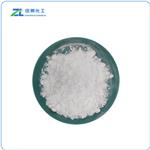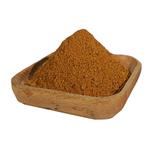Peroxidases (EC 1.11.1.x) are a diverse group of oxidoreductases using peroxide
as an electron acceptor. Their substrate spectrum ranges from hydrogen peroxide
decomposed by catalase (hydrogen-peroxide:hydrogen-peroxide oxidoreductase,
EC 1.11.1.6), phenolic compounds degraded by Mn-dependent and lignin peroxidases
(Mn(II):hydrogen-peroxide oxidoreductase, EC 1.11.1.13 and 1,2-bis
(3,4-dimethoxyphenyl)propane-1,3-diol:hydrogen-peroxide oxidoreductase, EC
1.11.1.14), and recalcitrant dyes by DyP-type peroxidases (reactive-blue-
5:hydrogen-peroxide oxidoreductase, EC 1.11.1.19).
Direct supplementation of peroxidases to food was applied for the degradation
of carotenoids used for coloring of cheese. The whey resulting from colored
cheese production has an orange-yellowish tint, which interferes with further usage
of the whey. Recently, a fungal peroxidase of the DyP-type was commercialized
for bleaching of this kind of whey fluid under the name MaxiBright (DSM). To
generate the hydrogen peroxide required by the peroxidase as a cofactor in situ, a
glucose oxidase and a b-galactosidase were employed as auxiliary enzymes.
lactoperoxidase is a glycoprotein with anti-microbial activity, it is used as a stabilizing ingredient to help improve formulation stability and product shelf-life. It is naturally occurring in milk.
Peroxidase, horseradish is used in the oxidation of luminol to 3-aminophthalate. It is often used in conjugates to determine the presence of a molecular target, especially in the detection of specific protein in a western blot after conjugation with antibody. Further, it is highly reactive toward human tumor cells.
ChEBI: N-(2-aminophenyl)-4-[[[4-(3-pyridinyl)-2-pyrimidinyl]amino]methyl]benzamide is a member of benzamides.
Peroxidases are widely distributed in plants, animals, and microorganisms, and they protect cells against the effects of oxidative stress and cell damage due to H2O2. Peroxidases (EC number 1.11.1.x) represent a large family of oxidoreductases known to catalyze the oxidation of various inorganic and organic substrates using H2O2. They have a common catalytic mechanism for the degradation of H2O2, a two-electron oxidation-reduction with three distinct steps. They are involved in biological processes such as the breakdown of toxins, heavy metal detoxification and hormone regulation. Additionally, they are used as catalysts in various industries, in clinical biochemistry, enzyme immunoassays, the removal of peroxides from industrial wastes and the synthesis of various aromatic chemicals[1].
Protein G is a bacterial cell wall protein, which has high affinity for immunoglobulin G (IgG). It is isolated from group G streptococcal strains. Peroxidase from Streptococcus sp. is used to maintain the H2O2 homeostasis in cells. It aids the regulation of ABC Mn2+-permease complex (psaBCA) genes.
Flammability and Explosibility
Not classified
The transformation of industrial dyes by manganese peroxidases from Bjerkandera adusta is a manganese-independent reaction .
[1] Pontsho Patricia Twala. “Breakthroughs in the discovery and use of different peroxidase isoforms of microbial origin.” AIMS Microbiology 6 3 (2020): 330–349.


